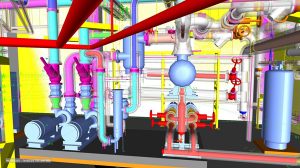- About
ABOUT US
- Membership
Membership
Discount Programs
Awards Programs
- Events
- Services & Resources
Construction Career Outreach
Legislative Advocacy
- Education & Apprenticeship
Apprenticeship
- News
ABC Wisconsin News
- Contact Us
ABOUT US
Membership
Discount Programs
Awards Programs
Construction Career Outreach
Legislative Advocacy
Apprenticeship
ABC Wisconsin News

Soon, walking through a construction site and envisioning what the completed project will look like won’t require an active imagination. Using virtual and augmented reality and Building Information Modeling (BIM), any element of the design will appear before your eyes.
To better understand what’s going on now and future developments in BIM, Andy Fischer, Applied Tech’s Professional Services Manager, sat down with Brandon Mikeal, a VDC/BIM Engineer at Turner Construction Company – one of the largest general contractors in the world that built Yankee Stadium and the Burj Khalifa in Dubai.
Applied Tech: What does BIM allow architecture, engineering and construction companies to do?
Brandon Mikeal: BIM provides a better way to visualize spaces and designs using data from your model. At a site in New York, we were able to load the model into HoloLens so someone could walk through the building with an artificial reality (AR) overlay of the finished project.
Applied Tech: How is it being used in the field today?
Brandon Mikeal: In theory it works, but use is limited. You need a strong internet connection, but on jobsites you frequently encounter dead spots and images jump around on the screen. Smaller devices don’t have the processors to handle the vector graphics for the model. Other solutions – like a VR backpack with a laptop and goggles – are too cumbersome if you’re not in a controlled environment. But, marketing departments are successfully using BIM with VR and AR in sales and office situations.

Applied Tech: How are AEC companies using BIM to sell projects?
Brandon Mikeal: In sales meetings, AEC companies can walk through an entire building model in 3D using an iPad. There are apps, like the one IKEA developed, which use AR to help consumers visualize how furniture will look in a space. Clients can test if it fits and decide which colors they like best. Similarly, architects can preload AR on a tablet and show how different options look during presentations.
Applied Tech: Do you see this driving more sales?
Brandon Mikeal: Definitely. The design becomes more real and leads to smarter decisions. Being able to actually see choices in front of you is more interactive and creates an emotional connection for the client. For AEC companies, it is a way to differentiate from competitors.
Applied Tech: What are some of the projects you’ve been working on?
Brandon Mikeal: Recently, my team has been building Facebook data centers in Nebraska and Iowa. We’re required to 3D model everything and rely heavily on laser scanning. We have a machine that looks like a ball on a tripod and it sends out millions of lasers. When they bounce back, the dimensions and properties are recorded so you’ve captured the entire space is recorded digitally.
Applied Tech: When I was there 6 years ago, there were only five Virtual Design and Construction (VDC) specialists for the entire territory you’re talking about. How many are there now?
Brandon Mikeal: It’s grown quite a bit since you left. There are 20-25 now.
Applied Tech: What are some of the things to come?
Brandon Mikeal: We’re developing a cost-loaded VR model that will enable us to “walk” through every room of a project and have clients pick out the features they want. The entire time, the model is calculating costs so the client will know how much they are spending and what will put the project over or under budget. We hoped this would be ready for our project of adding club and suite boxes to TCU’s football stadium, but more time was needed to develop the capabilities. We also see it being used for other projects, like in hospitals.
Applied Tech: What advice would you give AEC companies looking to adopt BIM right now?
Brandon Mikeal: First, find a way to differentiate it. VR is cool and a good visualization tool, but you need to ask, “Why do this instead of using a projector?” Second, get help from an IT expert. At Turner, we have the infrastructure to manage VR and AR on our own, but most AEC companies lack this internal support. Find a partner who will help you manage software licenses and improve jobsite connectivity.
Applied Tech: How do you see subcontractors using BIM?
Brandon Mikeal: BIM helps the AEC industry catch errors in the model. Using AR, I can work with a subcontractor in the field and virtually see if a door will hit a pipe as it opens before either are installed. It enables us to have a conversation, go back to the model and see how far we need to move the pipe to prevent the clash.
AR and VR will become more common as jobsite connectivity improves. Many AEC clients are already combining BIM with AR and VR on projects. For instance, an electrical subcontractor is being supported through:
Managing licenses: Activate licenses; consolidate and track hardware keys on a license server
Securing gear: Research options; provide troubleshooting and operational support
Improving connectivity and security at sites: Add access points to buildings, find jobsite internet solutions, manage devices
By Tom Nohelty, Applied Tech
Tom Nohelty is director of strategic services at Applied Tech, an information technology managed service provider and member of ABC, supporting AEC companies throughout Madison, Milwaukee and Central Wisconsin.
© ABC of Wisconsin | All Rights Reserved | Lion Tree Group Site Design | Privacy Policy